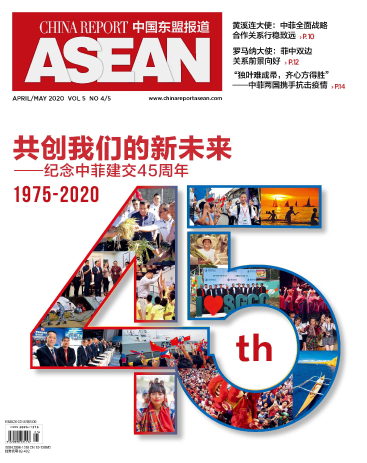On March 30, the first shipment of 7,656 kilograms of Philippine Hass avocados in 1,408 boxes arrived at Waigaoqiao Port in Shanghai. The arrival marked another successful cooperation program between China and the Philippines on agriculture within the framework of the Belt and Road Initiative (BRI). The Philippines, a major fruit supplier to China, became the first Asian country to export avocados to China.
Meanwhile, a total of 323 Jeeps ready for export to the Philippines arrived at Guangzhou Bonded Logistics Park, while export clearance procedures were completed simultaneously at Suidong Customs in Guangzhou, Guangdong Province. This export model allows bulk cargo to be declared as a whole even if the cargo is transported into the bonded logistic park in batches, more convenient and efficient than the traditional process, with less financial pressure on manufactures.
Revitalizing Economic Cooperation
Li Kuiwen, spokesperson for the General Administration of Customs of China and director of the Department of Statistical Analysis, noted in a briefing that in the first quarter of 2020, China’s import and export trade with ASEAN was significantly better than its foreign trade as a whole. ASEAN has replaced the EU as China’s largest trading partner with a 17.75 billion-dollar advantage. At present, China is the Philippines’ largest trading partner, largest source of imports, and third largest export destination.
According to China Customs statistics, the Philippines mainly exports garments and accessories, wooden crafts and furniture, electronic products, coconut oil and refined copper. Major imports include electronics, fossil fuels, industrial machinery and equipment, lubricants and related products, organic and inorganic chemicals, and transport equipment. The data shows that although China and the Philippines compete in the overall trade structure, the countries have considerable complementary advantages.
Xu Ningning, executive president of China-ASEAN Business Council, reported that in 2019, China-Philippines bilateral trade reached US$60.95 billion, an increase of 9.5 percent year-on-year, with US$40.75 billion of Chinese exports to the Philippines up 16.3 percent year-on-year. He attributed the rapid development of economic and trade relations between the two countries to four factors:
First, mutual confidence and trust. Close high-level exchange between the leaders of the two countries played a key role in economic and trade cooperation. The strategic partnership between the two sides has been continuously consolidated, providing effective support for economic cooperation.
Second, new growth momentum. In recent years, the Philippine economy has grown with its active “Build, Build, Build” program. Meanwhile, implementation of the BRI has injected new impetus into bilateral cooperation. The two sides have reached common understanding on cooperation projects and achieved remarkable early harvests.
Third, mutual complementary strengths. China and the Philippines have aligned their development plans and policies to explore complementary strengths in economic and trade cooperation and meet their own needs for development. In a changing international environment, Chinese and Philippine enterprises have actively adjusted their business strategies and enhanced cooperation with preferential trade and investment policies.
Fourth, open development. The upgrade of the ASEAN-China Free Trade Agreement (ACFTA) provides both sides with more opportunities to cooperate for new development in an open environment and enables them to face challenges through cooperation.
In August 2019, during Philippine President Duterte’s visit to China, the China-ASEAN Business Council and the Philippine Embassy in China co-sponsored a conference on investing in the Philippines. A Philippine vice minister of trade and industry delivered a keynote speech at the conference, outlining key areas for investment in the Philippines: infrastructure, manufacturing, agriculture, fisheries, forestry, health services, public housing, energy, tourism facilities, services and other areas.
Cooperation amid Quarantine
In the first quarter of 2020, China-Philippines bilateral trade contracted 3.6 percent year-on-year, with a 1.2 percent year-on-year drop in Chinese exports to the Philippines and an 8.3 percent year-on-year drop in Chinese imports from the Philippines. Xu attributes the negative growth to the COVID-19 outbreak. When the pandemic gets under control, economic and trade cooperation between the two countries is expected to gradually spring back to normalcy.
Because of the solid foundation, China-Philippines economic and trade cooperation did not stop due to the pandemic. Philippine Minister of Finance Carlos Dominguez remains confident in China’s economic prospects. The Philippine cabinet member pledged to strengthen communication and coordination with the Chinese side to minimize the negative impact of the pandemic on the regular movement of personnel and goods as well as on important cooperation projects. Philippine Minister of Transport Arthur Tugade stressed that the Philippines attaches great importance to maintaining the momentum of pragmatic cooperation between the two countries. He asserted that the country would do everything possible to minimize the negative impact of the pandemic on bilateral cooperation.
At an early stage of the epidemic, some experts suggested that goods imported from China be quarantined for 14 days, an idea that was flatly rejected by Leonor Penia, a Philippine entrepreneur who specializes in photovoltaic power generation. His statistics show that volume of China-Philippines trade of solar panels was about US$12 million in 2019, a figure that is expected to grow as high as US$360 million in the future.
“Chinese solar panels are cost-effective and reliable,” stressed Penia. “Chinese products don’t spread the virus, but help the Philippine people harness solar energy. If our trade with China gets interrupted, the Philippine solar energy industry would lose its competitive edge in the market. It would significantly impact our plans to introduce more renewable energy from China.”
The year 2020 is the China-ASEAN Year of Digital Economic Cooperation. Xu considers high-quality and innovative economic cooperation strong support for the strategic partnership between the two sides. He supports actively expanding cooperation in fields of e-commerce, smart cities, 5G networking and building a Digital Silk Road as well as sharing conveniences brought by science, technology and innovation.
China and the Philippines should also increase industrial cooperation and build a new industrial chain with complementary advantages while further promoting trade and investment liberalization and facilitation to seek win-win results, he added. They should vigorously develop potential for regional growth and jointly promote construction of the Regional Comprehensive Economic Partnership (RCEP) to ensure the signing of an agreement in 2020. They should also implement the China-BIMP-EAGA (Brunei Darussalam-Indonesia-Malaysia-Philippines East ASEAN Growth Area) Cooperation Action Plan (2020-2025) by promoting pragmatic cooperation in this area.
Meanwhile, companies from the two countries should work together to meet every challenge and transform crisis into opportunity by optimizing the structure of trade and investment and strengthening cooperation in finance, infrastructure, agriculture, tourism, marine economics and other realms.

A traditional dance performance at the opening ceremony of the Philippines Pavilion at the First China International Import Expo (CIIE) in Shanghai on November 6, 2018.

Signing ceremony of nine contracts worth more than US$4.6 billion at the Philippines-China (Chongqing) Trade and Investment Forum in Manila on September 16, 2019.
7,656 kilograms
1,408 boxes
On March 30, the first shipment of 7,656 kilograms of Philippine Hass avocados in 1,408 boxes arrived at Waigaoqiao Port in Shanghai.

In 2019, China-Philippines bilateral trade reached US$60.95 billion, an increase of 9.5 percent year-on-year, with US$40.75 billion of Chinese exports to the Philippines up 16.3 percent year-on-year.


 Copy Reference
Copy Reference